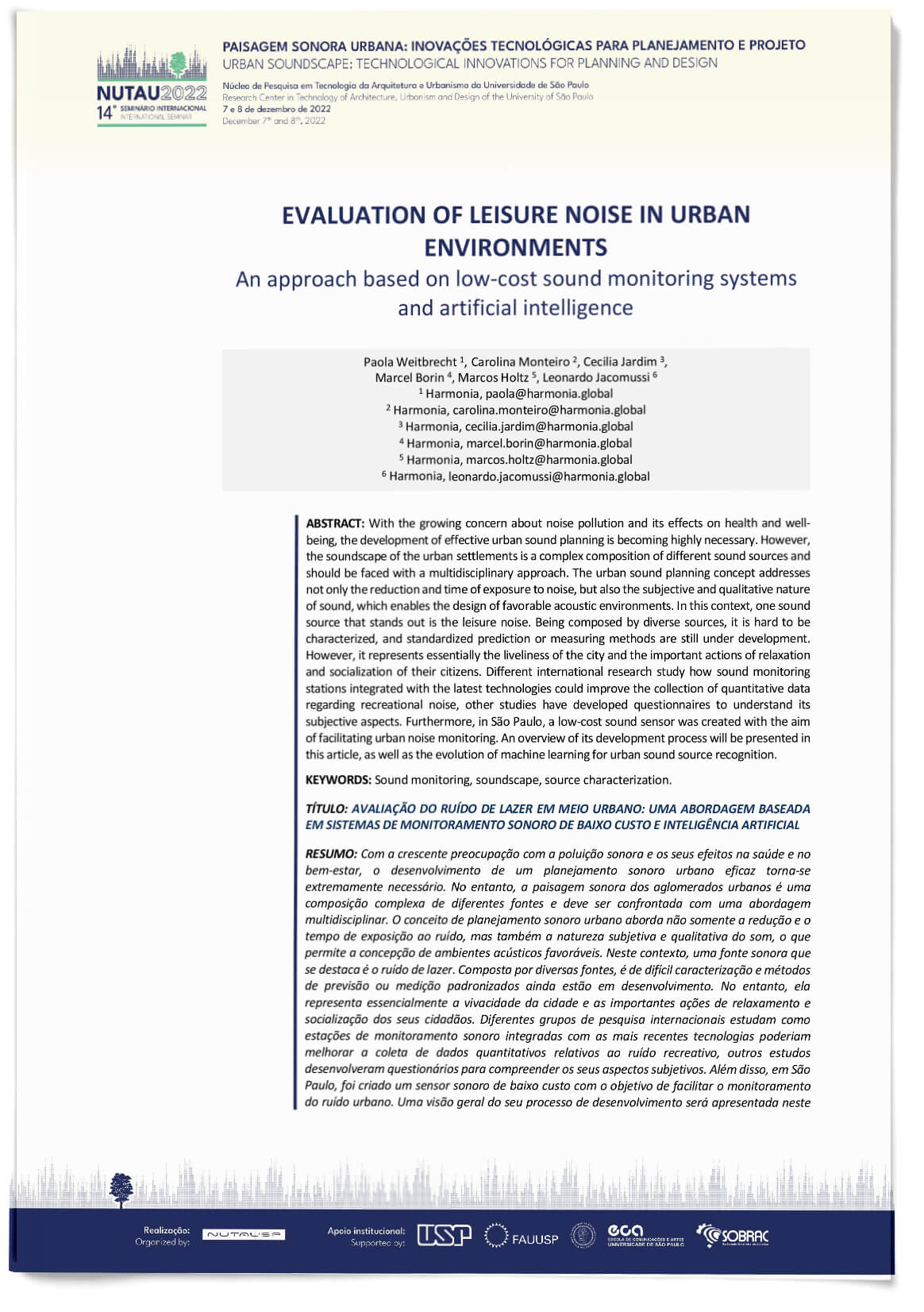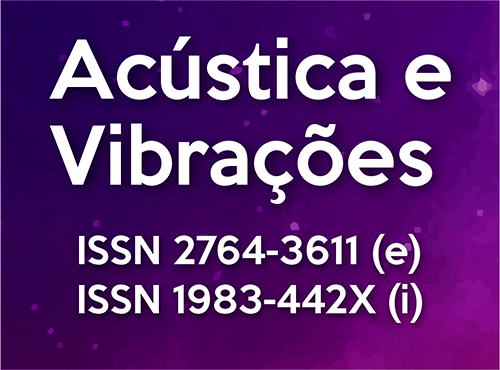Evaluation of leisure noise in urban environments
an approach based on low-cost sound monitoring systems and artificial intelligence
DOI:
https://doi.org/10.55753/aev.v38e55.237Keywords:
sound monitoring, soundscape, source characterizationAbstract
With the growing concern about noise pollution and its effects on health and well-being, the development of effective urban sound planning is becoming highly necessary. However, the soundscape of the urban settlements is a complex composition of different sound sources and should be faced with a multidisciplinary approach. The urban sound planning concept addresses not only the reduction and time of exposure to noise, but also the subjective and qualitative nature of sound, which enables the design of favorable acoustic environments. In this context, one sound source that stands out is the leisure noise. Being composed by diverse sources, it is hard to be characterized, and standardized prediction or measuring methods are still under development. However, it represents essentially the liveliness of the city and the important actions of relaxation and socialization of their citizens. Different international research study how sound monitoring stations integrated with the latest technologies could improve the collection of quantitative data regarding recreational noise, other studies have developed questionnaires to understand its subjective aspects. Furthermore, in São Paulo, a low-cost sound sensor was created with the aim of facilitating urban noise monitoring. An overview of its development process will be presented in this article, as well as the evolution of machine learning for urban sound source recognition.
References
(1) United Nations. (2018). 68% of the world population projected to live in urban areas by 2050, says UN. https://www.un.org/development/desa/en/news/population/2018-revision-of-world-urbanization-prospects.html (accessed April 19, 2022).
(2) Roberts, J. (2018). Noise pollution is one of the biggest health risks in city life | Research and Innovation. https://ec.europa.eu/research-and-innovation/en/horizon-magazine/noise -pollution-one-biggest-health-risks-city-life (accessed November 23, 2022).
(3) Kloth, M.; Vancluysen, K.; Clement, F.; Lars Ellebjerg, P. (2008). Practitioner Handbook for Local Noise Action Plans: Recommendations from the SILENCE project, 124.
(4) Kropp, W. et al. (2016). Urban sound planning - The SONORUS project.
(5) Bernfeld, D.; Revol, C.; Mietlicki, F. (2022). Regulation of nightlife noise in Paris: the contribution of innovative monitoring and perspectives. Proceedings of the 51st International Congress and Exposition on Noise Control Engineering (Inter-noise 2022).
(6) UOL. (2022). Reclamações por barulho crescem e superam nível pré-pandemia em SP. UOL Notícias. https://noticias.uol.com.br/ultimas-noticias/agencia-estado/2022/07/05/ reclamacoes-por-barulho-crescem-e-superam-nivel-pre-pandemia-em-sp.htm (accessed November 23, 2022).
(7) G1. (2022). No de reclamações de barulho na cidade de SP em 2022 é maior que antes de pandemia. https://g1.globo.com/sp/sao-paulo/noticia/2022/07/19/no-de-reclamacoes -de-barulho-na-cidade-de-sp-em-2022-e-maior-que-antes-de-pandemia.ghtml (accessed November 23, 2022).
(8) Cidade de São Paulo. (2022). Baixo Augusta. https://cidadedesaopaulo.com/novidades/ baixo-augusta/?lang=pt (accessed November 23, 2022).
(9) São Paulo (Município). (2014). Lei nº 16.050, de 31 de julho de 2014. Aprova a Política de Desenvolvimento Urbano e o Plano Diretor Estratégico do Município de São Paulo. Diário Oficial do Município de São Paulo.
(10) Associação Brasileira de Normas Técnicas (2019). Acústica – Medição e avaliação de níveis de pressão sonora em áreas habitadas – Aplicação de uso geral (ABNT NBR 10151).
(11) Ballesteros, M. J.; Fernández, M. D.; Flindell, I.; Torija, A. J.; Ballesteros, J. A. (2014). Estimating leisure noise in Spanish cities. Applied Acoustics, 86, 17–24. DOI: 10.1016/j.apacoust.2014.04.019. DOI: https://doi.org/10.1016/j.apacoust.2014.04.019
(12) Ottoz, E.; Rizzi, L.; Nastasi, F. (2015). Recreational noise in Turin and Milan: impact and costs of movida for disturbed residents, Proceedings of the 22nd International Congress on Sound and Vibration (ICSV22).
(13) Revol, C.; Bernfeld, D.; Mietlicki, F. Regulation of nightlife noise in Paris: the contribution of innovative monitoring and perspectives. Proceedings of the 51st International Congress and Exposition on Noise Control Engineering (Inter-noise 2022). DOI: https://doi.org/10.3397/IN_2022_0697
(14) Gallo, E.; Ciarlo, E.; Santa, M.; Sposato, E.; Vincent, B.; Halbwachs, Y. (2018). Analysis of leisure noise levels and assessment of policies impact in San Salvario district, Torino (Italy), by low- cost IoT noise monitoring network. Proceedings of the 11th European Congress and Exposition on Noise Control Engineering (Euronoise 2018), 699–704.
(15) MONICA. (2019). About MONICA - Sound and security applications for large, open-air events in the city. https://www.monica-project.eu/home/about-monica/ (accessed September 11, 2022).
(16) Weitbrecht, P.; Jacomussi, L.; Borin, M.; Monteiro, C.; Jardim, C. MEMs Based Low-Cost Urban Noise Monitoring: Tests and Case Study. Proceedings of the 51st International Congress and Exposition on Noise Control Engineering (Inter-noise 2022). DOI: https://doi.org/10.3397/IN_2022_0932
(17) Borin, M.; Holtz, M.; Jacomussi, L.; Monteiro, C.; Weitbrecht, P.; Jardim C. (2022). Automatic identification of city intrusive noises using deep learning. Anais do 12º Congresso Iberoamericano de Acústica e 29º Encontro da Sobrac (FIA 2020/22).
(18) Salamon, J.; Jacoby, C.; Bello, J. P. (2014). A Dataset and Taxonomy for Urban Sound Research. Proceedings of the 22nd ACM international conference on Multimedia (MM '14), 1041–1044. DOI: 10.1145/2647868.2655045. DOI: https://doi.org/10.1145/2647868.2655045
(19) Mu, W.; Yin, B.; Huang, X.; Xu, J.; Du, Z. (2021). Environmental sound classification using temporal-frequency attention based convolutional neural network. Scientific Reports, 11, 1–14. DOI: 10.1038/s41598-021-01045-4. DOI: https://doi.org/10.1038/s41598-021-01045-4

Published
How to Cite
Issue
Section
License
Copyright (c) 2023 Acoustics and Vibrations (Acústica e Vibrações)

This work is licensed under a Creative Commons Attribution-NonCommercial-ShareAlike 4.0 International License.




